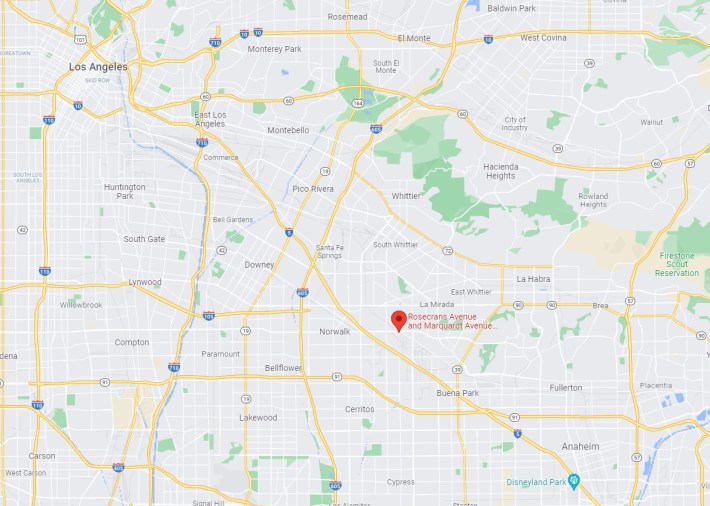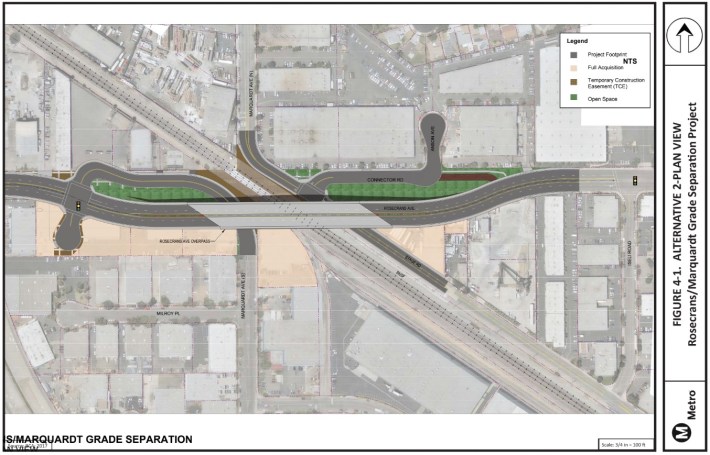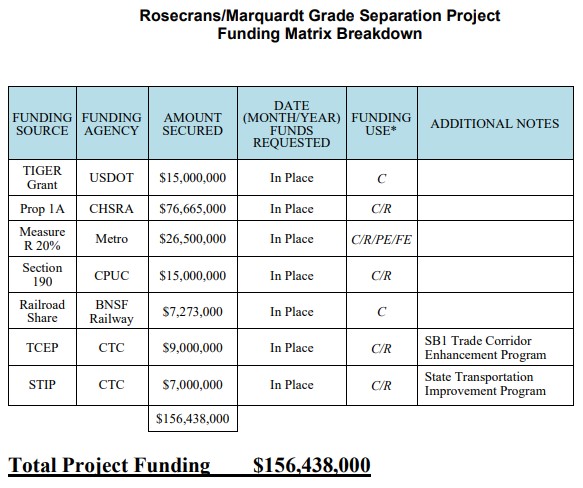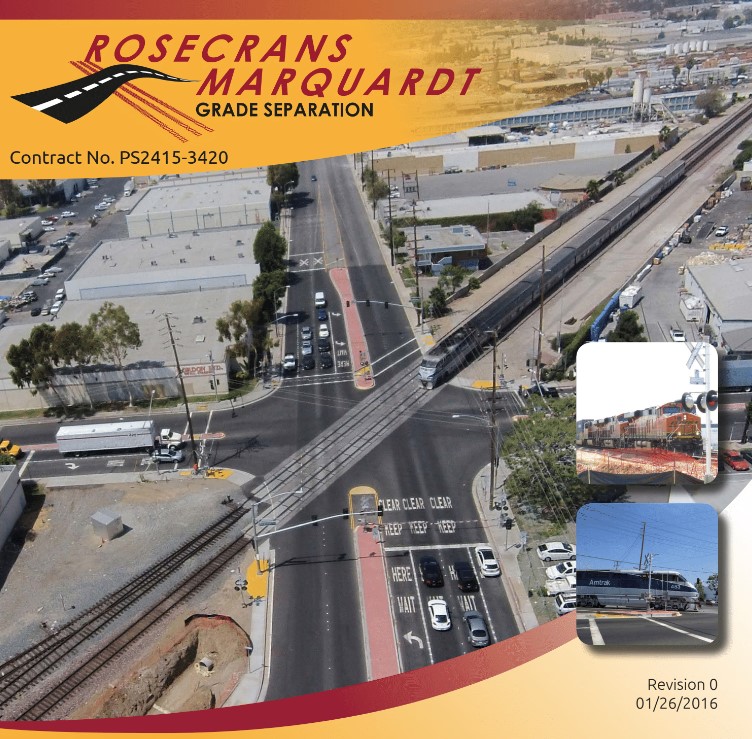Last week, the Metro board approved moving forward with a long-planned grade separation. The $156 million Rosecrans/Marquardt Grade Separation Project will construct a new bridge to safely carry car traffic over existing BNSF railroad tracks, also used by Metrolink and Amtrak - and planned to be used by California High-Speed Rail when the project is extended to Anaheim.
The Rosecrans/Marquardt project is located in the city of Santa Fe Springs, along the eastern edge of L.A. County, close to Orange County.

The existing intersection of Rosecrans Avenue and Marquardt Avenue has an at-grade railroad crossing. With somewhat frequent trains, traffic backs up on Rosecrans. In 2016, Metro's The Source reported that the California Public Utilities Commission (CPUC) rated the Rosecrans/Marquardt intersection as the most hazardous railroad crossing in California due to 22 vehicle and train crashes from 2013 through 2015. These resulted in four deaths and six injuries.

The new grade separation will benefit both rail passengers and drivers; both will be safer and will experience greater reliability.
Metro's project will add a new Rosecrans Avenue overpass and new connector roads. The project will sever the relatively low-traffic Marquardt Avenue, which is already interrupted by nearby creeks (Coyote Creek and its tributary La Cañada Verde Creek) and the 5 Freeway.

Metro's staff report notes that there is an approved plan for bike lanes on Rosecrans, but project construction only makes space for those bike lanes, without actually implementing them.
Per the staff report, the project final design is complete. Advance demolition work began in early 2020. Eight industrial buildings are being demolished. Four buildings have already been cleared, and the remaining demolitions will be completed by January 2022, when construction work will begin. The new grade separation is expected to open in 2023.

Metro pulled together numerous local, state and federal funding sources for the project. Rosecrans/Marquardt received a $15 million federal TIGER (Transportation Investment Generating Economic Recovery) grant awarded in 2016. At that time, the project was anticipated to cost $137 million and to be completed in January 2021.
Local funding includes $26 million from Metro's Measure R sales tax.
State funding includes some CPUC and S.B. 1 (gas tax) monies. The largest single source of money for the project - $77 million - is the California High-Speed Rail Authority (CAHSRA) allocating funding from the voter-approved rail bond Prop 1A.
Some legislators, including Assembly Speaker Anthony Rendon and Assemblymember Laura Friedman, have pushed for diverting high-speed rail funding away from the under-construction Central Valley spine and instead focusing on "areas where it will meet the greatest need, including the Bay Area and Los Angeles." While there are many reasons to find this push disingenuous, one is that CAHSRA is already investing in Bay Area and L.A. rail improvements. CAHSRA has funded several L.A. rail improvements, including Rosecrans/Marquardt and the Union Station run-through tracks.
In related news, last week the Metro board approved a motion - by boardmembers Kathryn Barger, Ara Najarian, and Hilda Solis - that makes a new agency policy to prioritize "the early delivery of additional, strategic, California High-Speed Rail (CHSR) capital projects in Los Angeles County rail corridors that currently serve and/or will one day serve regional and inter-city rail... if and when new sources of state and federal funding become available." This would include Metro grade separation projects like Rosecrans/Marquardt and Doran Street and Broadway/Brazil Grade Separation. The new funding sources could include federal infrastructure monies as well as the anticipated state budget surplus.
In her remarks [meeting video - starting at 6:28:00] last week, Supervisor Barger was quick to distance her Metro motion from Rendon and Friedman's efforts. Barger stated that the Metro motion was tailored to be "completely completely separate from the ongoing debates over remaining Prop 1A monies. We are not targeting central California money."
Barger represents North L.A. County communities including Santa Clarita, Palmdale, and Lancaster, which are served by Metrolink Antelope Valley Line commuter rail and by the High Desert multipurpose corridor where funding for a canceled freeway project is expected to be directed toward high-speed rail.
Barger has pushed for upgrades to the Metrolink Antelope Valley Line - some of which also received Metro board approval last week. The board approved certifying the Final Environmental Impact Report (EIR) for the Antelope Valley Line Service and Capacity Improvement Projects [staff report]. That project includes three components:
- Balboa Double Track Extension - just over a mile of new double tracks between Balboa Boulevard and Sierra Highway (between Sylmar and Santa Clarita - in the city of L.A.)
- Canyon Siding Extension - a mile and a half of new double tracks above and below the Santa Clarita Station, plus additional station upgrades
- Lancaster Terminal Improvements - expansion of the existing train layover facilities, plus additional station upgrades
Last week's Barger motion could serve to get more rail improvement projects, similar to Rosecrans/Marquardt, shovel-ready. The motion helps position Metro to receive more federal and state infrastructure monies to improve Southern California rail infrastructure, and prepare for future high-speed rail.







